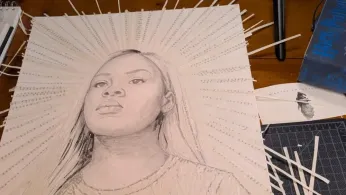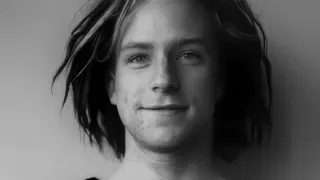
4 hours ago
Magic, Memory, and Mourning: Artist Reimagines 'Harry Potter' to Honor Murdered Trans Women
READ TIME: 3 MIN.
If you ask any queer person about the significance of Harry Potter, you’ll get an array of answers: nostalgia, escapism, formative queer readings, and—more recently—a sense of heartbreak. The series, once beloved for its tales of chosen family, has become a battleground for trans rights, as its author’s public statements have sparked global debate and protest within and beyond the LGBTQ+ community .
But in the hands of a bold artist, the cultural legacy of Harry Potter is being reclaimed—not for controversy, but for commemoration. Enter the spellbinding project that’s turning the pages of the wizarding world into portraits of murdered trans women, transforming pain into power and art into activism .
The artist—whose name is gaining recognition across queer media—sources actual Harry Potter books, tearing and layering their iconic pages as the backdrop for mixed-media portraits of trans women who lost their lives to anti-trans violence. Each artwork is a testament to both the stolen futures and the enduring presence of trans women, set against the very words of a franchise that’s become emblematic of the struggle for trans acceptance .
“In a way, I’m casting my own kind of spell,” the artist shared in an interview with PinkNews. “By using these books, I want viewers to confront the reality of what’s been said about trans people—and who is missing from those stories.” .
The portraits themselves are arresting: faces rendered in vibrant color, layered atop the sepia text of spells and stories, confronting viewers with both beauty and loss. Each piece is informed by research into the lives of the women commemorated, resisting the erasure that so often follows violence against the trans community .
The project is more than a visual memorial. It’s a pointed critique of how mainstream culture—especially celebrity authors and massive media franchises—can shape public attitudes toward marginalized groups. For many LGBTQ+ people, Harry Potter once represented hope and belonging; now, the series is a reminder of how easily those feelings can be weaponized against us .
For the artist, using the books as material is both a reclamation and a confrontation. “I think about all the queer kids who grew up loving these stories, only to feel betrayed by the author’s words. My portraits are for them, and for everyone who’s ever been told they don’t belong in the magic,” they explained .
The exhibition has sparked conversation and reflection across queer social media, as viewers share images and their own stories of navigating fandom as trans and non-binary people. Many express gratitude for the project’s refusal to let violence go unnoticed, and its insistence on remembering the names and faces of those lost .
This body of work invites us to ponder: Who owns our stories? Can art transform even the most painful associations into new sources of strength? For the LGBTQ+ community, particularly transgender people, the answer is a defiant yes. By literally reworking the pages of Harry Potter, the artist is demanding that trans lives be seen, celebrated, and mourned—not as tragic footnotes, but as central figures in our collective narrative .
The project resonates deeply at a time when anti-trans violence remains an urgent, global crisis. According to advocacy groups, 2025 has already seen a record number of reported murders of trans women, especially women of color—a trend that underscores the importance of visibility, remembrance, and solidarity .
By centering these stories, the artist’s work joins a lineage of queer art that insists on our right to joy, mourning, and survival. It’s a reminder that our magic is real, our losses are not invisible, and our futures are worth fighting for.
For many LGBTQ+ fans, this project is both a balm and a rallying cry. It’s proof that the worlds we love—even the ones that have hurt us—can be remade in our own image. “Trans people are magic,” one exhibition visitor wrote on Instagram (@TransMagicPortraits). “No one can take that away from us.”
As the portraits tour galleries and community spaces, their impact ripples outward. Queer artists, activists, and fans are beginning to imagine new forms of storytelling—ones that honor both the complexity of our histories and the beauty of our existence. Whether through art, protest, or everyday acts of self-love, the message is clear: We belong in every story, on every page, and in every kind of magic.






